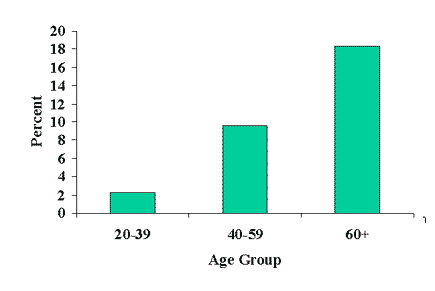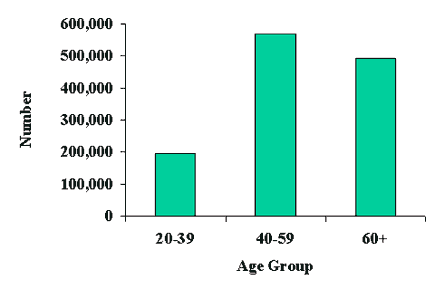




|
 |
Publications and Products
National Diabetes Fact Sheet
Return to the Table of Contents
National Estimates on Diabetes
 Methods
Methods
The data in this fact sheet were derived from various surveys of the
Centers for Disease Control and Prevention (CDC)—the National Health
Interview Survey (NHIS), the National Health and Nutrition Examination
Surveys (NHANES III and NHANES 1999-2000), the National Hospital Discharge
Survey, and surveys conducted through the Behavioral Risk Factor Surveillance
System. Other data sources include CDC's National Vital Statistics System,
the outpatient database of the Indian Health Service (IHS), the U.S. Renal
Data System of the National Institutes of Health (NIH), and published
studies. Many of the estimates were calculated from these data sources
by CDC and NIH staff.
Estimates of the total number of people with diabetes and the prevalence
of diabetes (both diagnosed and undiagnosed) per 100 population are model-based
estimates calculated from NHIS data, NHANES data, and population estimates.
Age-race-sex-specific diabetes prevalence estimates from the 1999-2001
NHIS and the 2002 outpatient database of the IHS were applied to 2002
census estimates to calculate the number of diagnosed cases of diabetes.
The number of persons with undiagnosed diabetes was calculated by applying
age-specific estimates from NHANES 1999-2000 to 2002 census estimates.
Total prevalence was calculated based on the number of people with both
diagnosed and undiagnosed diabetes.
The summary estimates reported in this fact sheet have some variability
due to the limits of the measurements and the estimation procedures. However,
it is the consensus opinion of the participating organizations that they
are the best current estimates of the burden of diabetes. More detail
on the data sources, references, and methods are available at http://www.cdc.gov/diabetes/pubs/factsheet.htm.
 Total prevalence of diabetes in the United States, all ages, 2002
Total prevalence of diabetes in the United States, all ages, 2002
Total: 18.2 million people — 6.3% of the population —
have diabetes.
Diagnosed: 13.0 million people
Undiagnosed: 5.2 million people
 Prevalence of diagnosed diabetes among people under 20 years of age, United
States, 2002
Prevalence of diagnosed diabetes among people under 20 years of age, United
States, 2002
About 210,000 people under 20 years of age have diabetes. This represents
0.26% of all people in this age group.
Approximately one in every 400 to 500 children and adolescents has type
1 diabetes.
Although type 2 diabetes is a problem among youth, nationally representative
data to monitor diabetes trends among youth are not available. Clinic-based
reports and regional studies indicate that type 2 diabetes is becoming
more common among children and adolescents, particularly in American Indians,
African Americans, and Hispanic/Latinos.
 Total prevalence of diabetes among people aged 20 years or older, United
States, 2002
Total prevalence of diabetes among people aged 20 years or older, United
States, 2002
Age 20 years or older: 18.0 million; 8.7% of all people
in this age group have diabetes.
Age 60 years or older: 8.6 million; 18.3% of all people
in this age group have diabetes.
Men: 8.7 million; 8.7% of all men aged 20 years or
older have diabetes.
Women: 9.3 million; 8.7% of all women aged 20 years
or older have diabetes.
|
Total prevalence of diabetes in people aged 20 years or older, by age group—United States, 2002

Source: 1999–2001 National Health Interview Survey and 1999-2000 National Health and Nutrition Examination Survey estimates projected to year 2002.
Detailed
information about this graph is available.
|
 Total prevalence of diabetes by race/ethnicity among people aged 20 years
or older, United States, 2002
Total prevalence of diabetes by race/ethnicity among people aged 20 years
or older, United States, 2002
Non-Hispanic whites: 12.5 million; 8.4% of all non-Hispanic whites
aged twenty years or older have diabetes.
Non-Hispanic blacks: 2.7 million; 11.4% of all non-Hispanic
blacks aged twenty years or older have diabetes. On average, non-Hispanic
blacks are 1.6 times as likely to have diabetes than non-Hispanic whites
of similar age.
Hispanic/Latino Americans: 2.0 million; 8.2% of all
Hispanic/Latino Americans aged twenty years or older have diabetes. On
average, Hispanic/Latino Americans are 1.5 times more likely to have diabetes
than non-Hispanic whites of similar age. Mexican Americans, the largest
Hispanic/Latino subgroup, are over twice as likely to have diabetes as
non-Hispanic whites of similar age. Similarly, residents of Puerto Rico
are 1.8 times more likely to have diagnosed diabetes than U.S. non-Hispanic
whites. Sufficient data are not available to derive more specific current
estimates for other Hispanic/Latino groups.
American Indians and Alaska Natives who receive care from the
Indian Health Service (IHS): 110,814; 14.9% of American Indians
and Alaska Natives aged 20 years or older and receiving care from IHS
have diabetes. At the regional level, diabetes is least common among Alaska
Natives (8.2%) and most common among American Indians in the southeastern
United States (27.8%) and southern Arizona (27.8%). On average, American
Indians and Alaska Natives are 2.2 times as likely to have diabetes as
non-Hispanic whites of similar age.
Asian Americans and Native Hawaiian or other Pacific Islanders:
In 2002, Native Hawaiians and Japanese and Filipino residents of Hawaii
aged twenty years or older were approximately 2 times as likely to have
diagnosed diabetes as white residents of Hawaii of similar age. Prevalence
data for diabetes among other Pacific Islanders or Asian Americans are
limited, but some groups within these populations are at increased risk
for diabetes.
|
Age-adjusted total prevalence of diabetes in people aged 20 years or older, by race/ethnicity—United States, 2002

Source: 1999–2001 National Health Interview Survey and 1999-2000 National Health and Nutrition Examination Survey estimates projected to year 2002. 2002 outpatient database of the Indian Health Service.
Detailed
information about this graph is available.
|
 Incidence of diabetes, United States, 2002
Incidence of diabetes, United States, 2002
New cases diagnosed per year: 1.3 million people aged 20 years
or older.
|
Number of new cases of diagnosed diabetes in people aged 20 years or older, by age group—United States, 2002

Source: 1999–2001 National Health Interview Survey estimates projected to year 2002.
Detailed
information about this graph is available.
|
 Deaths among people with diabetes, United States, 2000
Deaths among people with diabetes, United States, 2000
- Diabetes was the sixth leading cause of death listed on U.S. death
certificates in 2000. This ranking is based on the 69,301 death certificates
in which diabetes was listed as the underlying cause of death. Altogether,
diabetes contributed to 213,062 deaths.
- Diabetes is likely to be underreported as a cause of death. Studies
have found that only about 35% to 40% of decedents with diabetes have
diabetes listed anywhere on the death certificate and only about 10%
to 15% have it listed as the underlying cause of death.
- Overall, the risk for death among people with diabetes is about 2
times that of people without diabetes.
 Complications of diabetes in the United States
Complications of diabetes in the United States
Heart disease and stroke
- Heart disease is the leading cause of diabetes-related deaths. Adults
with diabetes have heart disease death rates about 2 to 4 times higher
than adults without diabetes.
- The risk for stroke is 2 to 4 times higher among people with diabetes.
- About 65% of deaths among people with diabetes are due to heart disease
and stroke.
High blood pressure
- · About 73% of adults with diabetes have blood pressure greater
than or equal to 130/80 mm Hg or use prescription medications for hypertension.
Blindness
- Diabetes is the leading cause of new cases of blindness among adults
aged 20-74 years.
- Diabetic retinopathy causes 12,000 to 24,000 new cases of blindness
each year.
Kidney disease
- Diabetes is the leading cause of end-stage renal disease, accounting
for 44 percent of new cases.
- In 2001, 42,813 people with diabetes began treatment for end-stage
renal disease.
- In 2001, a total of 142,963 people with end-stage renal disease due
to diabetes were living on chronic dialysis or with a kidney transplant.
Nervous system disease
- About 60% to 70% of people with diabetes have mild to severe forms
of nervous system damage. The results of such damage include impaired
sensation or pain in the feet or hands, slowed digestion of food in
the stomach, carpal tunnel syndrome, and other nerve problems.
- Severe forms of diabetic nerve disease are a major contributing cause
of lower-extremity amputations.
Amputations
- More than 60% of nontraumatic lower-limb amputations occur among people
with diabetes.
- In 2000-2001, about 82,000 nontraumatic lower-limb amputations were
performed annually among people with diabetes.
Dental disease
- Periodontal (gum) disease is more common among people with diabetes.
Among young adults, those with diabetes have about twice the risk of
those without diabetes.
- Almost one-third of people with diabetes have severe periodontal diseases
with loss of attachment of the gums to the teeth measuring 5 millimeters
or more.
Complications of pregnancy
- Poorly controlled diabetes before conception and during the first
trimester of pregnancy can cause major birth defects in 5% to 10% of
pregnancies and spontaneous abortions in 15% to 20% of pregnancies.
- Poorly controlled diabetes during the second and third trimesters
of pregnancy can result in excessively large babies, posing a risk to
the mother and the child.
Other complications
- Uncontrolled diabetes often leads to biochemical imbalances that can
cause acute life-threatening events, such as diabetic ketoacidosis and
hyperosmolar (nonketotic) coma.
- People with diabetes are more susceptible to many other illnesses
and, once they acquire these illnesses, often have worse prognoses.
For example, they are more likely to die with pneumonia or influenza
than people who do not have diabetes.
 Cost of diabetes in the United States
Cost of diabetes in the United States
Total (direct and indirect): $132 billion
Direct medical costs: $92 billion
Indirect costs: $40 billion (disability, work loss, premature
mortality)
These data are based on a study conducted by the Lewin Group, Inc.
for the American Diabetes Association and are 2002 estimates of both the
direct costs (cost of medical care and services) and indirect costs (costs
of short-term and permanent disability and of premature death) attributable
to diabetes. This study uses a specific cost-of-disease methodology to
estimate the health care costs that are due to diabetes.
Top of page
Historical
Page last modified: December 20, 2005
Content Source: National Center for Chronic Disease Prevention and Health Promotion
Division of Diabetes Translation
|
